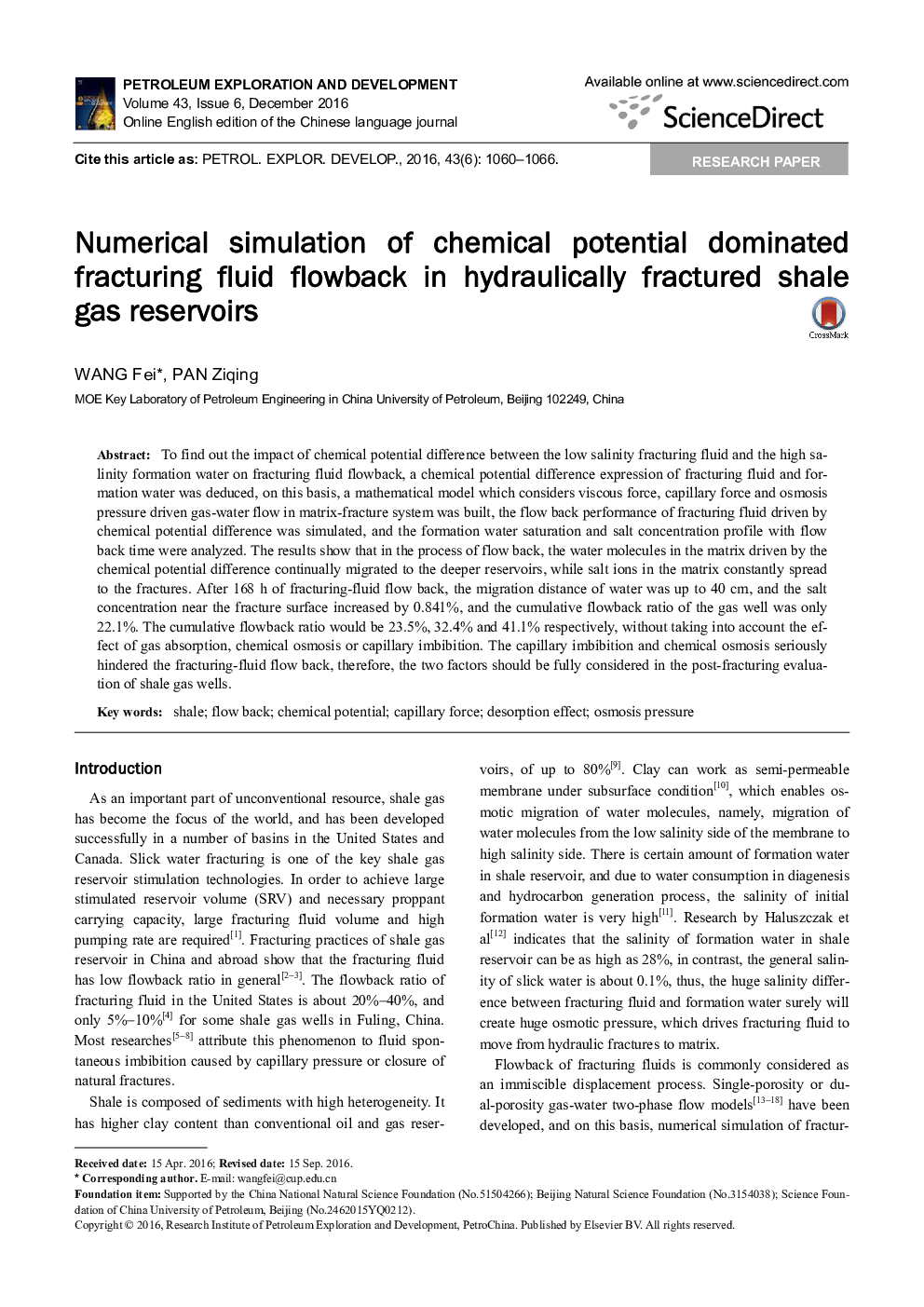| کد مقاله | کد نشریه | سال انتشار | مقاله انگلیسی | نسخه تمام متن |
|---|---|---|---|---|
| 8912318 | 1639330 | 2016 | 7 صفحه PDF | دانلود رایگان |
عنوان انگلیسی مقاله ISI
Numerical simulation of chemical potential dominated fracturing fluid flowback in hydraulically fractured shale gas reservoirs
ترجمه فارسی عنوان
شبیه سازی عددی پتانسیل شیمیایی در جریان انبساط مایعات شکستگی در مخازن گاز هیدرولیکی شکست خورده گازهای شیل
دانلود مقاله + سفارش ترجمه
دانلود مقاله ISI انگلیسی
رایگان برای ایرانیان
کلمات کلیدی
شیل، جریان برگشتی، پتانسیل شیمیایی، نیروی مویرگی، اثر تمیز کردن، فشار اسمز،
ترجمه چکیده
برای برآورد تأثیر پتانسیل شیمیایی بین مایع شکست شکست کم شور و آب تشکیل شوری بالا بر روی جریان مایعات شکستگی، بیانگر اختلاف پتانسیل پراکندگی مایعات شکستگی و شکل گیری آب، بر اساس این مدل، یک مدل ریاضی که در نظر گرفته شد، چسبناک نیروی مویرگی و جریان گاز-اسمز معکوس جریان گاز در سیستم شکستگی ماتریکس ساخته شده است، عملکرد جریان بازگشتی از سیال شکستگی رانده شده به وسیله اختلاف پتانسیل شیمیایی شبیه سازی شده، و شکل اشباع آب و مشخصات غلظت نمک با زمان برگشت . نتایج نشان می دهد که در جریان بازگشت، مولکول های آب در ماتریس که به وسیله اختلاف پتانسیل شیمیایی هدایت می شوند، به طور دائمی به مخازن عمیق مهاجرت می کنند، در حالی که یون های نمکی در ماتریس به طور مداوم به شکستگی ها گسترش می یابد. پس از 168 ساعت بازگشت مایع شکستگی، جریان مهاجرت آب به 40 سانتی متر و غلظت نمک در نزدیکی سطح شکستگی به میزان 0.841 درصد افزایش یافت و نسبت جریان جریان انباشته شده در چاه گاز تنها 22.1 درصد بود. نسبت جریان برگشتی تجمعی به ترتیب 23.5٪، 32.4٪ و 41.1٪ خواهد بود، بدون توجه به تاثیر جذب گاز، اسمز معکوس یا جذب مویرگی. جذب مویرگی و اسمز شیمیایی به طور جدی مانع بازگشت جریان مایعات شکستگی می شوند، بنابراین، در هر دو آزمایش، باید هر دو عامل را در ارزیابی پس از شکست در چاه های نفت شیل بررسی کرد.
موضوعات مرتبط
مهندسی و علوم پایه
علوم زمین و سیارات
ژئوشیمی و پترولوژی
چکیده انگلیسی
To find out the impact of chemical potential difference between the low salinity fracturing fluid and the high salinity formation water on fracturing fluid flowback, a chemical potential difference expression of fracturing fluid and formation water was deduced, on this basis, a mathematical model which considers viscous force, capillary force and osmosis pressure driven gas-water flow in matrix-fracture system was built, the flow back performance of fracturing fluid driven by chemical potential difference was simulated, and the formation water saturation and salt concentration profile with flow back time were analyzed. The results show that in the process of flow back, the water molecules in the matrix driven by the chemical potential difference continually migrated to the deeper reservoirs, while salt ions in the matrix constantly spread to the fractures. After 168 h of fracturing-fluid flow back, the migration distance of water was up to 40 cm, and the salt concentration near the fracture surface increased by 0.841%, and the cumulative flowback ratio of the gas well was only 22.1%. The cumulative flowback ratio would be 23.5%, 32.4% and 41.1% respectively, without taking into account the effect of gas absorption, chemical osmosis or capillary imbibition. The capillary imbibition and chemical osmosis seriously hindered the fracturing-fluid flow back, therefore, the two factors should be fully considered in the post-fracturing evaluation of shale gas wells.
ناشر
Database: Elsevier - ScienceDirect (ساینس دایرکت)
Journal: Petroleum Exploration and Development - Volume 43, Issue 6, December 2016, Pages 1060-1066
Journal: Petroleum Exploration and Development - Volume 43, Issue 6, December 2016, Pages 1060-1066
نویسندگان
Fei WANG, Ziqing PAN,
